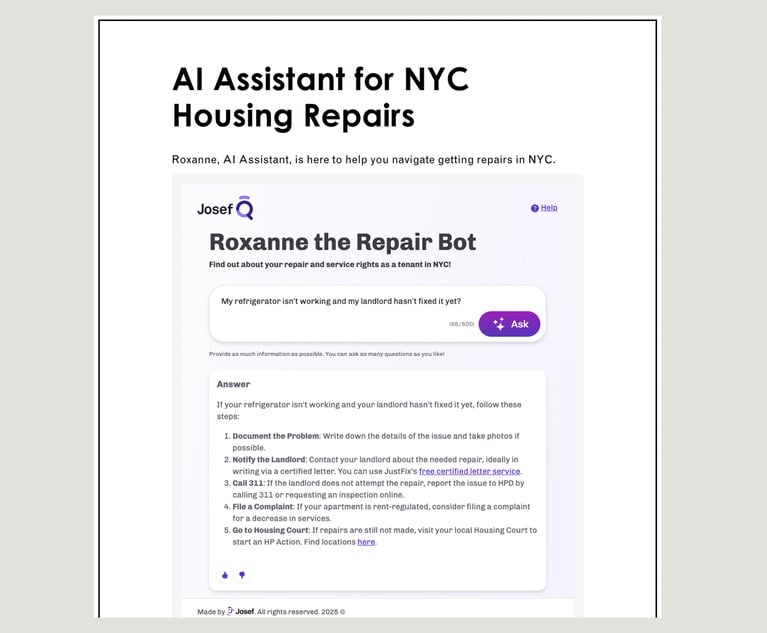Amid Spike in Courthouse Immigration Arrests, ICE Issues Formal Policy
U.S. Immigration and Customs Enforcement announced Wednesday it has issued a formal policy on making arrests in federal, state and local courthouses, saying it will target convicted criminals and persons considered threats to public safety, but leaving a window open for arrests under “special circumstances.”
February 01, 2018 at 05:07 PM
3 minute read

U.S. Immigration and Customs Enforcement announced Wednesday it has issued a formal policy on making arrests in federal, state and local courthouses, saying it will target convicted criminals and persons considered threats to public safety, but leaving a window open for arrests under “special circumstances.”
The written policy was dated Jan. 10, 2018, nearly one year since President Donald Trump's inauguration. In that time ICE has stepped up enforcement, chalking up more than 111,000 arrests between Jan. 20, 2017, when Trump took the oath of office, and Sept. 30, a 42 percent increase over the same time period in 2016.
In New York, there were more than 130 arrests by ICE agents at courthouses across the state in 2017, according to the Immigrant Defense Project, of which roughly three-quarters occurred at courthouses in New York City. The previous year, ICE made 11 arrests at courthouses.
Lucian Chalfen, a spokesman for the Office of Court Administration, said in an email that ICE has made three arrests at New York City courthouses this year.
Chalfen said the written policy is a “direct result” of court system officials' communications with ICE and that court system officials work to ensure that arrests do not disrupt court functions.
“We will continue to request that they treat all courthouses as sensitive locations, and will continue to raise these issues with ICE officials,” Chalfen said.
The policy, which became effective on Jan. 10, directs ICE agents to spare friends and family members of their targets when making courthouse arrests and to avoid areas of courthouses dedicated to noncriminal proceedings, like family courts or small claims courts.
“Federal, state and local law enforcement officials routinely engage in enforcement activity in courthouses throughout the country because many individuals appearing in courthouses for one matter are wanted for unrelated criminal or civil violations,” the directive states.
The policy also takes an apparent jab at so-called “sanctuary cities”—it states that courthouse arrests are made necessary by the “unwillingness” of some jurisdictions to cooperate with ICE agents on transferring immigrant detainees.
In a statement, the Immigrant Defense Project said the written policy is not new and “really just a continuation” of what ICE has been doing since Trump took office.
“ICE will continue to stalk and arrest survivors of violence, young people and people with serious mental illness, just as they have been for the past year,” the statement reads. “This policy will do nothing to change that practice. The threat that ICE poses to public safety and to the fair administration of justice remains.”
Marianne Yang, supervising attorney and co-director of the Center for Appellate Litigation's Immigrant Justice Project, which pursues post-conviction relief for defendants at risk for deportation because of their conviction, said ICE's stepped-up arrests in New York courthouses over the past year has struck fear not only into immigrants facing criminal proceedings, but also in complaining witnesses and immigrants who need to go to courthouses for noncriminal matters.
“It's that sense of fear to come forward in a place that, No. 1, is supposed to protect some people, No. 2 be a place to answer their charges,” said Yang .
This content has been archived. It is available through our partners, LexisNexis® and Bloomberg Law.
To view this content, please continue to their sites.
Not a Lexis Subscriber?
Subscribe Now
Not a Bloomberg Law Subscriber?
Subscribe Now
NOT FOR REPRINT
© 2025 ALM Global, LLC, All Rights Reserved. Request academic re-use from www.copyright.com. All other uses, submit a request to [email protected]. For more information visit Asset & Logo Licensing.
You Might Like
View All
Meet the Long Island Judge Tapped to Be US Attorney for Eastern District of New York
2 minute read
New York’s Property Tax Incentives and Abatements Make Development Feasible
7 minute read
Josef Partners With NYU, Housing Court Answers to Launch AI Assistant Built for Tenants

Trending Stories
Who Got The Work
Michael G. Bongiorno, Andrew Scott Dulberg and Elizabeth E. Driscoll from Wilmer Cutler Pickering Hale and Dorr have stepped in to represent Symbotic Inc., an A.I.-enabled technology platform that focuses on increasing supply chain efficiency, and other defendants in a pending shareholder derivative lawsuit. The case, filed Oct. 2 in Massachusetts District Court by the Brown Law Firm on behalf of Stephen Austen, accuses certain officers and directors of misleading investors in regard to Symbotic's potential for margin growth by failing to disclose that the company was not equipped to timely deploy its systems or manage expenses through project delays. The case, assigned to U.S. District Judge Nathaniel M. Gorton, is 1:24-cv-12522, Austen v. Cohen et al.
Who Got The Work
Edmund Polubinski and Marie Killmond of Davis Polk & Wardwell have entered appearances for data platform software development company MongoDB and other defendants in a pending shareholder derivative lawsuit. The action, filed Oct. 7 in New York Southern District Court by the Brown Law Firm, accuses the company's directors and/or officers of falsely expressing confidence in the company’s restructuring of its sales incentive plan and downplaying the severity of decreases in its upfront commitments. The case is 1:24-cv-07594, Roy v. Ittycheria et al.
Who Got The Work
Amy O. Bruchs and Kurt F. Ellison of Michael Best & Friedrich have entered appearances for Epic Systems Corp. in a pending employment discrimination lawsuit. The suit was filed Sept. 7 in Wisconsin Western District Court by Levine Eisberner LLC and Siri & Glimstad on behalf of a project manager who claims that he was wrongfully terminated after applying for a religious exemption to the defendant's COVID-19 vaccine mandate. The case, assigned to U.S. Magistrate Judge Anita Marie Boor, is 3:24-cv-00630, Secker, Nathan v. Epic Systems Corporation.
Who Got The Work
David X. Sullivan, Thomas J. Finn and Gregory A. Hall from McCarter & English have entered appearances for Sunrun Installation Services in a pending civil rights lawsuit. The complaint was filed Sept. 4 in Connecticut District Court by attorney Robert M. Berke on behalf of former employee George Edward Steins, who was arrested and charged with employing an unregistered home improvement salesperson. The complaint alleges that had Sunrun informed the Connecticut Department of Consumer Protection that the plaintiff's employment had ended in 2017 and that he no longer held Sunrun's home improvement contractor license, he would not have been hit with charges, which were dismissed in May 2024. The case, assigned to U.S. District Judge Jeffrey A. Meyer, is 3:24-cv-01423, Steins v. Sunrun, Inc. et al.
Who Got The Work
Greenberg Traurig shareholder Joshua L. Raskin has entered an appearance for boohoo.com UK Ltd. in a pending patent infringement lawsuit. The suit, filed Sept. 3 in Texas Eastern District Court by Rozier Hardt McDonough on behalf of Alto Dynamics, asserts five patents related to an online shopping platform. The case, assigned to U.S. District Judge Rodney Gilstrap, is 2:24-cv-00719, Alto Dynamics, LLC v. boohoo.com UK Limited.
Featured Firms
Law Offices of Gary Martin Hays & Associates, P.C.
(470) 294-1674
Law Offices of Mark E. Salomone
(857) 444-6468
Smith & Hassler
(713) 739-1250






